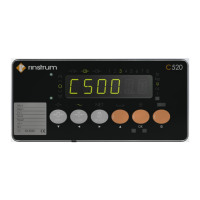14 Ethernet Interface
14.1 Overview
The Ethernet interface provides connectivity via a standard 802.3 network. The indicator contains a 100MBit
Ethernet interface. This interface allows connectivity to other networked devices, such as PCs. The indicator
IP network settings can be configured from the menus under ETH.NET. See Section 5.6. Fixed or DHCP assigned
addresses can be used. When DHCP is used, the IP settings are read-only so the device’s IP address can be
determined.
In addition, the operator menu provides the IP.INFO menu to quickly view the device’s IP settings. See
Section 6.
14.1.1 Web Interface
The indicator provides a simple web interface that can be accessed from a web browser on a PC. The web
interface allows new firmware to be uploaded to the indicator.
14.1.2 TCP Socket Interfaces
The indicator provides two TCP socket interfaces for extracting data from the indicator.
1. Referred to as TCP.IN.1 within the indicator, this interface provides a bi-directional TCP socket connec-
tion over which the standard indicator serial command set can be used. The indicator viewer (C500-510)
uses this interface when using a TCP connection.
2. Referred to as TCP.IN.2 within the indicator, this interface provides a uni-directional TCP socket con-
nection over which the indicator can transmit Automatic Output data.
A maximum of 20 concurrent connections shared between TCP.IN.1 and TCP.IN.2 are permitted.
Note
If the connection limit is being reached, it may be because connections are not
being closed by clients, and left hanging. Setting a timeout value may solve this
issue. See T.OUT in Section 5.5.
14.1.3 UDP Socket Interfaces
The indicator provides four UDP socket interfaces for extracting data from the indicator.
1. Two outgoing UDP sockets (UDP.O.1 and UDP.O.2):
(a) These sockets will read commands from and send data to a fixed IP and UDP port combination
specified by SERIAL:UDP.O.x:DST.IP and SERIAL:UDP.O.x:DST.PRT.
(b) The port type (auto output, network, etc) can be configured independently for each port.
(c) Setting the type to off, or setting the destination IP address to 0.0.0.0 or destination port to 0
disables the socket.
(d) The indicator source port will be the same as the destination port (SERIAL:UDP.O.x:DST.PRT).
2. Two incoming UDP sockets (UDP.IN.1 and UDP.IN.2):
(a) These sockets listen for data on a specified UDP port (SERIAL:UDP.IN.x:PORT) with in the indicator.
(b) They read commands from any source IP and port and send reply data to the last source IP and
port that sent data.
(c) The port type (auto output, network, etc) can be configured independently for each port.
62 C500-600-2.0.3

